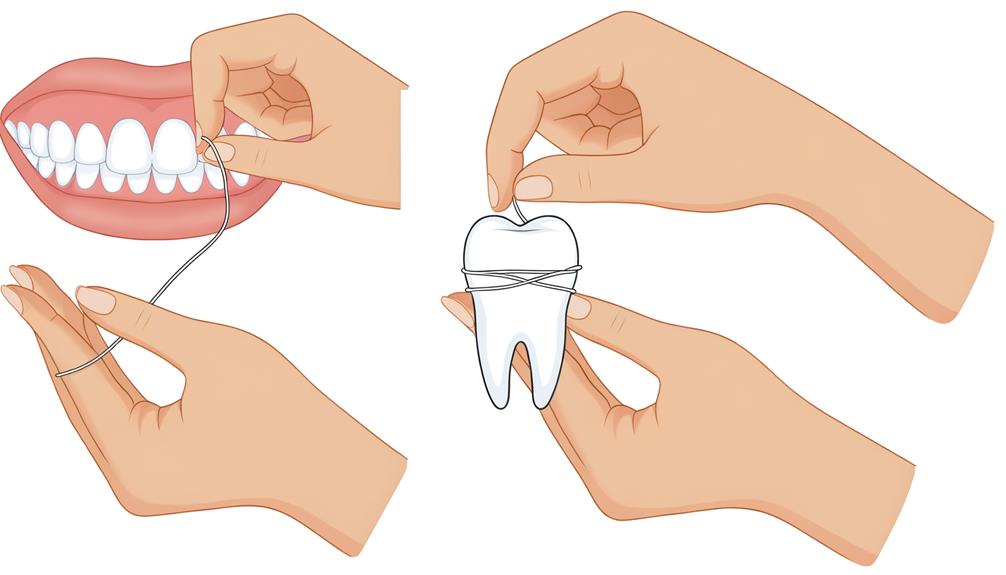To address the distressing but sadly common often ignored problem of tooth decay, getting a few flossing techniques right from day 1 can be your best bet at achieving success. First off, choosing the right floss is essential—waxed for tight spaces, softer for sensitive gums. The “wrap technique” gets down to the gum line, disrupting stubborn plaque cities hidden beneath.
Have you ever heard of or perhaps tried a water flosser? They are like pressure washers for your teeth, blasting away debris with ease. And don’t skimp on length; an 18-inch piece of floss guarantees you are not just moving plaque from one party spot to another. Remember, it all boils down to gentle moves and patience. Stick with it, and you are well on the road to recovery towards a healthier mouth and excellent dental health overall.
Key Takeaways
- Use an 18-inch piece of floss to avoid reusing plaque-covered sections.
- Gently slide the floss under the gum line and curve it around each tooth base.
- Choose the right type of floss for your teeth and gum sensitivity to enhance cleaning efficiency.
- Incorporate the wrap technique to ensure a thorough cleaning beneath the gum line and around every tooth.
- Consider using a water flosser for a gentle alternative that effectively targets plaque and debris.
The Importance of Daily Flossing
Flossing daily is vital for removing plaque and food particles that often lead to tooth decay. You’ve probably heard it a million times from your dentist, but it’s because they know the drill—quite literally. When you floss, you’re not just getting rid of leftovers from lunch; you’re safeguarding your smile against the sneaky culprits of cavities and gum disease. The proper flossing technique involves gently sliding the floss up and down along the sides of each tooth, making sure to dip below the gum line where stubborn plaque likes to hide out. This is essential because plaque beneath the gum line is like a secret clubhouse for bacteria, plotting ways to cause trouble for your teeth.
But here’s the thing, mastering flossing doesn’t come overnight. It’s an art form where precision meets patience. By regularly flossing, you disrupt the party plaque and food particles are having between your teeth, preventing them from inviting tooth decay to join. So, remember, a few minutes spent flossing each day saves you from the woes of cavities and keeps your gum line in tip-top shape. It’s a small step for your daily routine but a significant leap for your oral health.
Choosing the Right Floss
Selecting the right floss is essential for enhancing your oral hygiene routine and ensuring that your teeth and gums remain healthy. With a myriad of types of floss available, choosing one might feel like trying to pick your favorite ice cream flavor at a shop with endless options. But don’t fret; it’s simpler than it seems.
For starters, consider your personal needs. If you’ve got teeth that are tight friends, waxed dental floss might be your ally, sliding between them with ease. On the flip side, if you’re dealing with gum sensitivity, softer, spongier floss types could be your go-to, ensuring a gentle but effective clean.
Don’t forget about those hard-to-reach spots. If you’re sporting braces or have dental work that makes traditional flossing as challenging as threading a needle while riding a rollercoaster, floss threaders or super floss are game changers, designed to navigate the nooks and crannies with precision.
Mastering the Wrap Technique

Mastering the wrap technique revolutionizes your oral hygiene routine by ensuring each tooth receives focused attention beneath the gum line. By adopting this method, you’re not just going through the motions; you’re engaging in a meticulous battle against tooth decay. Imagine wrapping each tooth in a gentle hug with your floss, curving it in a C shape to embrace every contour. This isn’t just about moving the floss up and down; it’s about ensuring that every nook and cranny is free from plaque and debris.
The beauty of the wrap technique lies in its simplicity and effectiveness. By thoroughly cleaning beneath the gum line and around each tooth base, you’re taking a proactive step to prevent the sneaky development of interproximal cavities—those unwelcome guests that love to crash between your teeth. It’s like you’re telling tooth decay, “Not today!”
Incorporating this technique into your daily oral hygiene regime isn’t just a smart move; it’s a game-changer. You’ll not only enhance your overall oral hygiene but also master the art of flossing. So, grab that floss and let’s wrap things up—literally. Your teeth, and your dentist, will thank you.
Flossing With Water Flossers
Explore the world of water flossers, a groundbreaking tool that targets plaque and debris with precision, offering a gentle yet impactful alternative to traditional string floss. If you’ve ever found string floss a bit of a hassle or you’re maneuvering around braces or dental work, water flossers could be your oral hygiene game-changer. They use a steady stream of water to flush out food particles and plaque that hide in the nooks and crannies of your teeth and gums, ensuring an all-around clean that’s hard to achieve with string alone.
What’s more, water flossers are a boon for your gums’ health. They’re gentle enough to not cause unnecessary irritation yet effective at reducing gum inflammation and bleeding—a common issue with harsher flossing methods. If you’ve got braces, implants, or other dental work, water flossers can get into those hard-to-reach areas without the risk of snagging or damaging your dental investments.
Adding a water flosser to your daily oral hygiene routine could greatly elevate your plaque removal efficiency, ensuring that your mouth remains a clean, healthy environment free from the threats of tooth decay and gum disease. Remember, consistency is key to mastering this tool and achieving the best results for your oral health.
Addressing Common Flossing Challenges
Despite its benefits, many individuals find flossing challenging due to common issues like discomfort or difficulty maneuvering the floss. If you’re struggling, remember that mastering the best flossing technique takes patience and practice. First off, make sure you’re using about 18 inches of floss, allowing you to maneuver a clean section between each tooth. This prevents the reuse of plaque-covered floss, reducing the risk of gum disease.
For those with sensitive teeth, gentle flossing is key. Don’t force the floss too hard against your gums, as this could cause more harm than good. Instead, softly curve the floss around the base of each tooth, making sure you’re thorough but gentle. This method helps to effectively remove plaque without irritating sensitive gums.
If you’re finding it tricky to reach certain areas, consider a floss holder. These handy tools can make it easier to navigate those hard-to-reach spots, ensuring every tooth gets the attention it deserves.
Frequently Asked Questions
Does Flossing Prevent Tooth Decay?
Yes, flossing does prevent tooth decay. It’s like your toothbrush’s best buddy, reaching those tight spots between your teeth where food particles love to hide. By flossing daily, you’re evicting bacteria and plaque, those uninvited guests that lead to cavities. Think of it as your secret weapon in the battle against tooth decay. So, grab that floss and get to work—your teeth will thank you for it!
How Do You Floss Without Damaging Your Teeth?
To floss without hurting your teeth, you’ve gotta be gentle. Start by sliding the floss between your teeth with a careful sawing motion. Don’t just snap it in there — that’s asking for trouble. Hug each tooth with the floss, curving it around in a “C” shape, and slide it up and down, covering the entire tooth surface. This method cleans effectively, dodging damage and keeping your smile safe.
How Can I Protect My Teeth From Decay?
To keep your pearly whites in tip-top shape, you’ve got to fight tooth and nail against decay. Don’t just brush twice daily; flossing is your secret weapon. Slide that floss gently between each tooth, making sure you hug the sides to whisk away hidden plaque. Consider a floss holder for an easier grip. Throw in fluoride toothpaste and a swish of mouthwash, and you’re not just fighting decay, you’re winning.
What Is the C Shape Flossing Technique?
The C shape flossing technique is like hugging each tooth with floss to clean every nook. You’ll gently wrap the floss in a C shape around each tooth, sliding it beneath the gumline to whisk away hidden plaque and bits of food. It’s a bit like being a tooth detective, seeking out hidden culprits causing decay. Mastering this method can be a game-changer for your oral hygiene routine, keeping your smile bright and healthy.
Conclusion
In wrapping up, remember that flossing is your mouth’s best friend in the fight against tooth decay. As the old saying goes, ‘A stitch in time saves nine,’ and regular flossing is that essential step for your dental health. Whether you’re a traditionalist with string floss or a tech-savvy enthusiast for water flossers, the key is consistency. Keep up the good work, and not only will your dentist thank you, but your smile will too.

